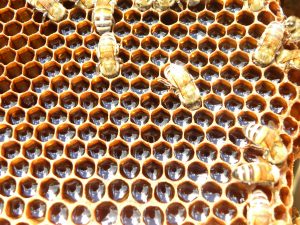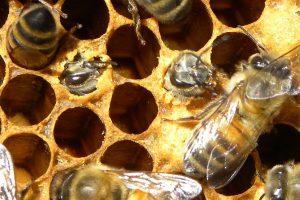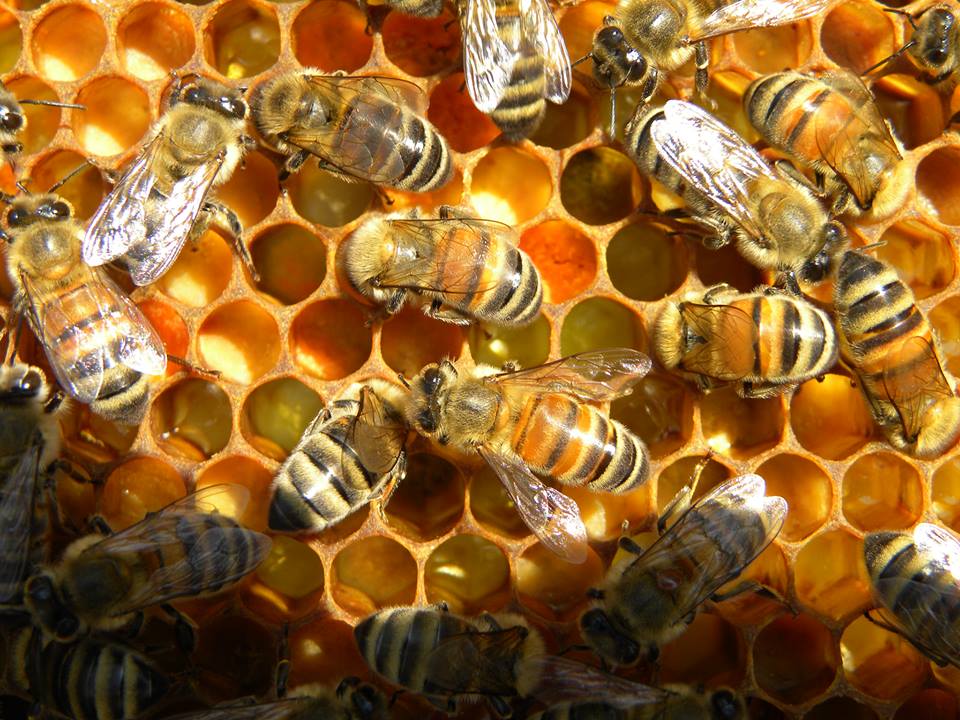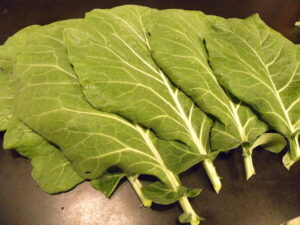I did not have a great beekeeping season here in NH, but not for the reasons you might have heard about, like colony collapse disorder, pesticide kills, or varroa mites.

Orange & Yellow Pollen in the Comb
My hives came through last winter well, four full hives and one smaller nucleus hive. The spring was slow to really get going, but they hung in there and started building up their work forces well, bringing in dandelion nectar and so much beautiful pollen (you can see them packing it away in the photo here). I implemented my non-chemical mite control strategies at the correct times and my bees looked and acted healthy. I hoped for a great honey harvest, and in the meantime started making splits to start new colonies to expand my apiary. I planned to go into this winter with at least five nucleus colonies that could be my new hives for 2017 rather than buying any Southern bee packages.
And then… the drought hit us.
At the beginning of May we in the Seacoast of NH were classified as “abnormally dry” and by now we are at the “extreme drought” level. All over New England, in a strange, spotty pattern, the drought is hitting farms, wildlife, and wells. Hay was hard to come by (we had to order it from Vermont), our garden and orchard suffered… and the bees.

Turning Nectar into Honey
The nectar that honey bees bring to their hives to turn into honey starts off with about 80% water content. So, if a plant is dehydrated it can’t make much nectar. The bees go out to forage, but just don’t find much to collect to make honey out of.
My overwintered hives only made a small amount of extra honey – they need the first 75# for themselves, and there wasn’t much more than that. What excess I did pull out, I gave to my new little nucleus hives who barely made any with their small number of foragers. I have had to step in and feed them sugar water – which is just not as nutritious or healthy for them. But bad food is better than starvation, and the weather is not their fault.

Workers Emerging
All my hives are strong and show no signs of illness at this point. I kept up my mite control all summer – drone comb removal, doing some splitting to create broodless periods, and dusted them with powdered sugar at specific broodless times. Most importantly, I got all my new queens from Northern beekeepers: Troy Hall in NH and Bob Brachmann in upstate NY. The research I’ve seen and my experience

Queen Bees from Troy Hall
point to the tremendous importance of genetics and of bee stock that is adapted to our colder climate. Counting on genetics, breeding and evolution to help us save our bees is certainly not a quick fix – but, as Permaculture Principle #9 tells us: Slow and Steady Wins the Race.
Two of my hives also made their own queens, which I will be watching

Queen Bee on comb
closely to evaluate. They were hives with fabulous Russian Queens from Bob Brachmann. They came through two winters beautifully, have been gentle and productive. But I had no say in the drones their daughter queens mated with and don’t really trust that all my fellow local beekeepers aren’t using a lot of Southern bee stock. There’s actually not enough Northern stock to supply us all at this point. So, I fear that I will have trouble doing good queen breeding here – but it never hurts to try, especially when the bees did most of the work of it!
I am feeding and prepping my hives for a winter that’s predicted to be a long, snowy one. We’ll all try to get through that and hope for a better season next year.
Beyond hoping, I am also reminded that the personal is political and it’s important to keep agitating for good environmental and energy policy. I have plans to get more involved with some of 350 New Hampshire‘s campaigns over the winter, while the bees and gardens sleep!


